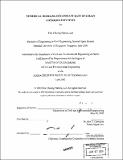| dc.contributor.advisor | John T. Germaine. | en_US |
| dc.contributor.author | Lee, Yew Choong Patrick, 1975- | en_US |
| dc.contributor.other | Massachusetts Institute of Technology. Dept. of Civil and Environmental Engineering. | en_US |
| dc.date.accessioned | 2006-03-24T16:02:39Z | |
| dc.date.available | 2006-03-24T16:02:39Z | |
| dc.date.copyright | 2003 | en_US |
| dc.date.issued | 2003 | en_US |
| dc.identifier.uri | http://hdl.handle.net/1721.1/29564 | |
| dc.description | Thesis (M.Eng.)--Massachusetts Institute of Technology, Dept. of Civil and Environmental Engineering, 2003. | en_US |
| dc.description | Includes bibliographical references (leaves 95-96). | en_US |
| dc.description.abstract | Constant Rate of Strain Consolidation Testing (CRSC) is an effective testing method to determine cohesive soil properties including stress history, compressibility, hydraulic conductivity and coefficient of consolidation. However, testing at varying strain rates have resulted in inconsistent results with respect to expected soil behavior. This theoretical study develops at numerical model to simulate the important details of a CRSC test using a finite difference approach in a spreadsheet in Microsoft Excel. The model provides a tool which can be used to study the test interpolation errors. The model based on void ratio versus log of effective vertical stress and versus log of hydraulic conductivity relationship of soil and includes the pore pressure compressibility of base measuring system. Parametric studies are preformed on Resedimented Boston Blue Clay normally consolidated behavior to investigate the effects of apparatus compressibility and strain rate. Finally, the predicted base pore pressure from the model simulation are used with the conventional interpretation equations to quantify the errors in soil parameters due to apparatus compressibility. It was found that bottom drainage of the specimen into the measuring system in a pore pressure distribution such that the base excess pore water pressure is not equal to the maximum excess pore water pressure. The magnitude of this difference increases with strain rate and neutral plane location. When using the conventional interpretation, this causes a shift in the compression curve to higher effective vertical stress. The error is small when the pore water pressure ratio is less than 5%. The error in hydraulic conductivity is much more significant and causes an overestimate of the hydraulic conductivity. This research forms the basis for which future experimental validation, normally consolidated to overly consolidated and steady state to transient state analysis. It can form the basis of new theories for the interpretation of constant rate of strain consolidation tests. | en_US |
| dc.description.statementofresponsibility | by Yew Choong Patrick Lee. | en_US |
| dc.format.extent | 96 leaves | en_US |
| dc.format.extent | 3219333 bytes | |
| dc.format.extent | 3219141 bytes | |
| dc.format.mimetype | application/pdf | |
| dc.format.mimetype | application/pdf | |
| dc.language.iso | eng | en_US |
| dc.publisher | Massachusetts Institute of Technology | en_US |
| dc.rights | M.I.T. theses are protected by copyright. They may be viewed from this source for any purpose, but reproduction or distribution in any format is prohibited without written permission. See provided URL for inquiries about permission. | en_US |
| dc.rights.uri | http://dspace.mit.edu/handle/1721.1/7582 | |
| dc.subject | Civil and Environmental Engineering. | en_US |
| dc.title | Numerical modeling of constant rate of strain consolidation tests | en_US |
| dc.title.alternative | Numerical evaluation of constant rate of strain consolidation tests | en_US |
| dc.type | Thesis | en_US |
| dc.description.degree | M.Eng. | en_US |
| dc.contributor.department | Massachusetts Institute of Technology. Department of Civil and Environmental Engineering | |
| dc.identifier.oclc | 52724990 | en_US |
